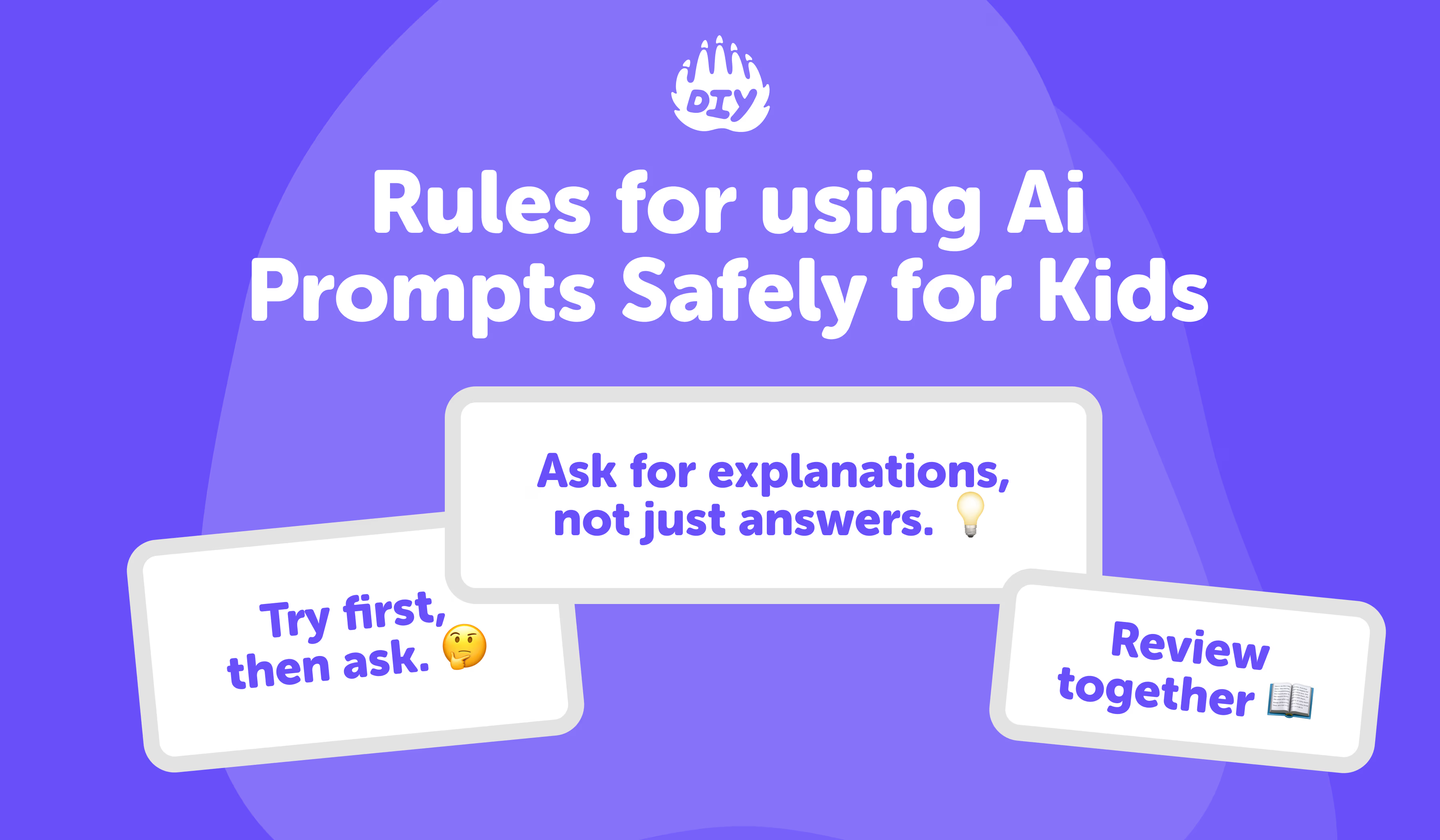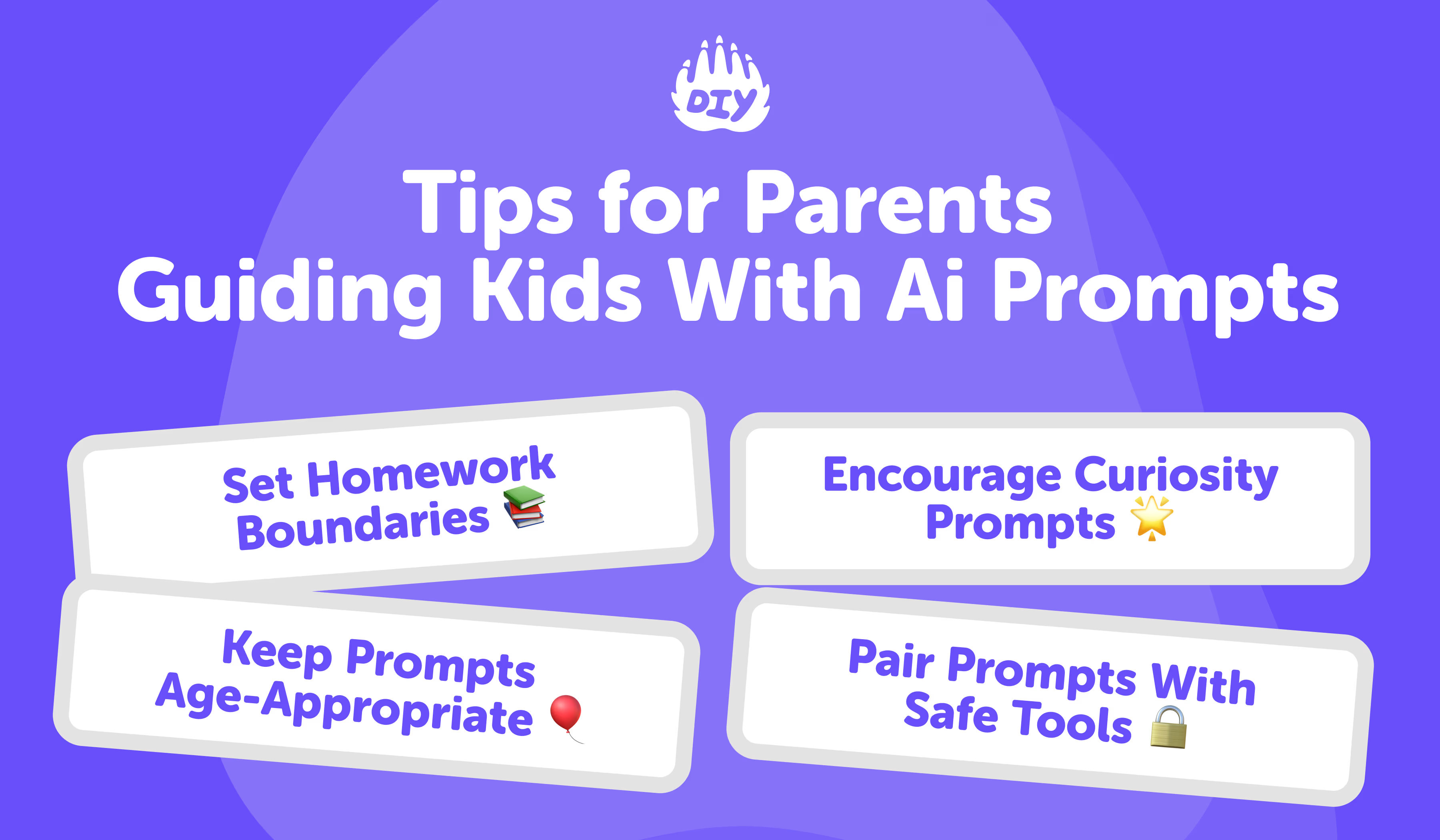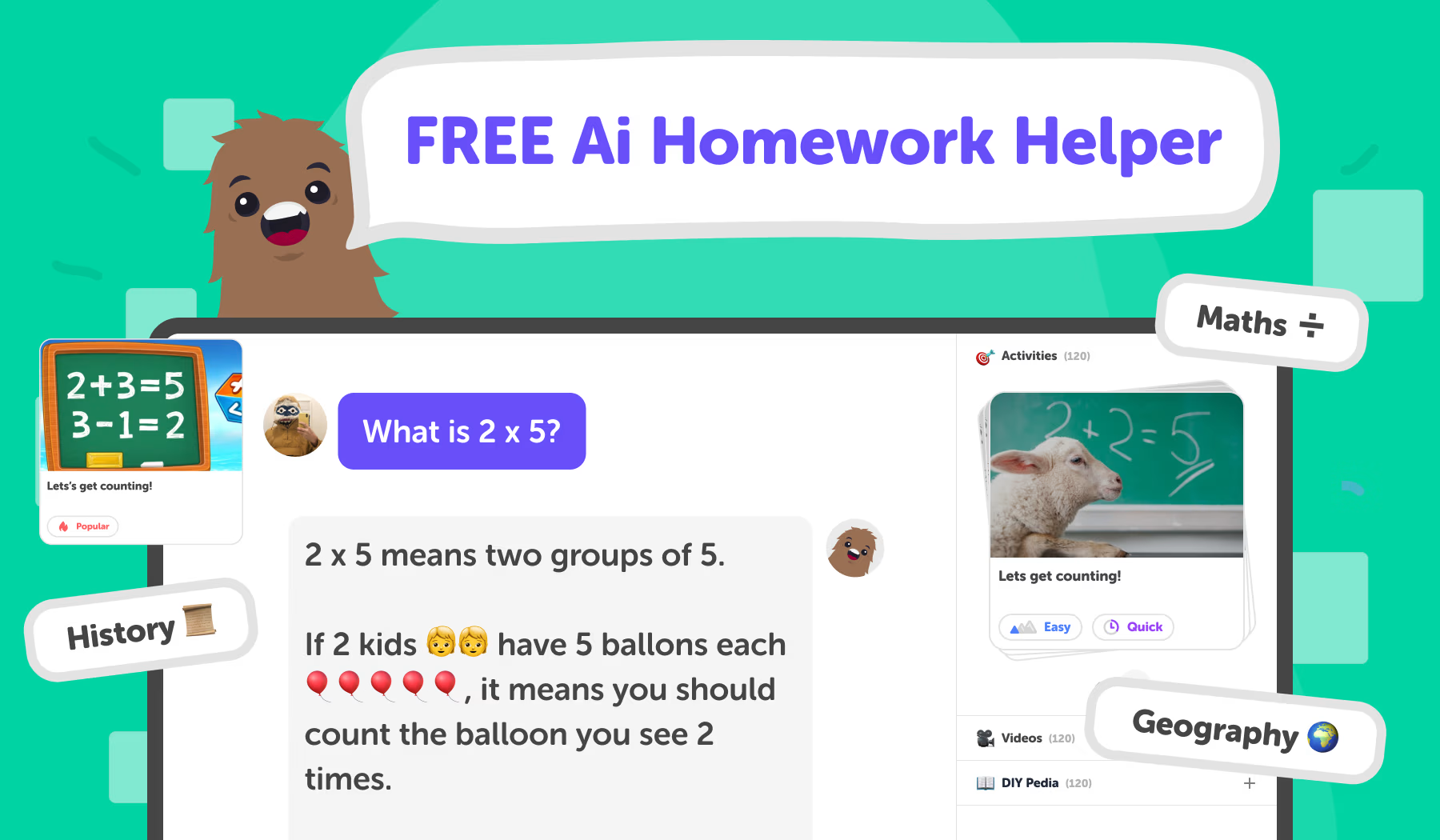If your child gets stuck on homework, the right prompt can turn ChatGPT into a calm tutor not a shortcut. Below are kid-friendly prompts that ask for explanations, steps, and practice, so students learn the idea and finish in their own words.
These prompts support learning. Kids should still write answers themselves and follow class rules.
Why Prompts Matter in ChatGPT
Prompts are like steering wheels; they guide where the conversation goes. For kids, learning to ask the right questions is just as important as understanding the answers. And for parents, knowing which prompts to encourage can mean the difference between ChatGPT becoming a study partner or a cheat sheet.
That’s where tools like the AI Homework Helper come in. They’re built to take the guesswork out of prompting by automatically guiding kids toward learning-focused conversations. But if your child is using ChatGPT directly, these 25 prompts will help keep the focus on learning, not shortcuts.
Rules for using these Prompts Safely

Try first, then ask. Kids should attempt homework problems before using a prompt to check or clarify.
Ask for explanations, not just answers. The goal is understanding, not copy-paste.
Review together. Parents can sit with kids and talk about what the AI explained.
All-purpose homework prompts (any subject)
“Explain {topic} in three levels: kid-friendly, middle school, and advanced each with a tiny example.”
“Show the step-by-step method for {problem type}. Don’t reveal the final answer until I try.”
“Make a 10-minute study plan for {unit} with practice tasks.”
“Quiz me on {chapter} with 5 questions, one at a time. If I’m wrong, give a hint first.”
“List common mistakes students make with {skill} and how to avoid them.”
“Turn my notes into a checklist and a 3-question self-test.”
“Compare {concept A} and {concept B} in a short table I can study.”
“Give me a memory trick or analogy for {concept}.”
“Create a mini project idea I can do in 30–60 minutes to practice {topic}.”
“Ask me to teach back what I learned. Ask follow-ups if I miss something.”
Math prompts (arithmetic → algebra → geometry)
“Explain {skill} for {grade} with a small worked example.”
“Make 5 practice problems on {topic} from easy to challenge; check my work after each.”
“Show two different methods to solve {problem type} and when to use each.”
“Turn this word problem into equations, then guide me step by step.”
“Create a mistake-spotting worksheet for {topic} (include the right corrections).”
“Build a real-life scenario that uses {concept} (e.g., percentages while shopping).”
“Give me a quick formula recap and one practice set (5 problems).”
“Explain why the formula for {area/volume/etc.} works with a picture description.”
“Make a speed drill (10 questions, 2 minutes) for {facts/skills}.”
“Create a review mix: 3 easy, 3 medium, 2 hard on {unit}.”
Science prompts (biology, chemistry, physics, earth science)
“Explain {concept} like I’m in {grade}, then add a one-line real-world use.”
“Give a cause → effect chain for {process} (e.g., photosynthesis).”
“Write a lab-style procedure to test {idea} with safe home materials.”
“Compare {two organisms/materials/forces} in a short table.”
“Turn my vocabulary list into kid-friendly definitions plus a 3-question quiz.”
“Describe a diagram for {system} and label the parts (text only).”
“Explain units and measurements needed for {experiment}, with example calculations.”
“Give a common misconception about {topic} and correct it.”
“Create 5 multiple-choice questions for {chapter}, then explain each answer.”
“Link {concept} to something familiar (sports, cooking, music) with a short analogy.”
Reading & writing prompts (ELA)
“Ask me reading comprehension questions about this paragraph: {paste passage}.”
“Help me find the main idea and supporting details of {text}.”
“Give a paragraph outline for {essay prompt} (hook, claim, reasons, conclusion). I’ll write it myself.”
“Create vocabulary practice (definition, sentence, synonym) for these words: {list}.”
“Show a strong vs. weak topic sentence for {topic} and why.”
“Make a PEEL/TEEEL paragraph guide for {argument}.”
“Turn {book/chapter} into a 5-question discussion I can answer in my own words.”
“Give transition words and sentence starters for {purpose} (compare, cause/effect, narrative).”
“Help me plan a summary in 5 bullet points for {text/video}.”
“Turn grammar rule {rule} into a mini-lesson with 5 quick practice items.”
History & geography prompts
“Explain {event/era} in a short timeline for {grade}.”
“Compare {two leaders/regions} (goals, actions, outcomes) in a table.”
“Create a map-study checklist: landforms, climate, and resources for {region}.”
“Give cause, event, effect for {historical event}.”
“Turn this set of notes into 3 flashcards and a 2-minute recap.”
“Suggest a primary-source question I can research about {topic}.”
“Write 5 short-answer practice questions for {unit} with model points.”
“Explain bias/perspective using two short viewpoints on {issue}.”
“Build a compare/contrast frame for {civilizations/periods}.”
“Make a study game (true/false + multiple choice) for {chapter}.”
Languages & ESL prompts
“Teach {vocab theme} with picture-style word descriptions (no images).”
“Create a dialogue practice for {situation} (greeting, ordering food, asking directions).”
“Make fill-in-the-blank sentences to practice {tense/grammar} and then check my answers.”
“Turn these words into collocations/phrases I can memorize.”
“Give a pronunciation tip and syllable breakdown for {tricky words}.”
“Write a mini-story using my vocab list; then ask 3 comprehension questions.”
“Convert my paragraph into simpler English without changing the meaning (for ESL).”
“Create a spaced-repetition plan for these 20 words.”
“Generate picture-free prompts so I can describe objects in English.”
“Give transition phrases for telling a story (first, then, after, finally).”
Study skills prompts (planning, organization, test prep)
“Build a 7-day study plan for {unit} with 30-minute sessions and a light review on day 7.”
“Turn my messy notes into a clean outline and 3 key takeaways.”
“Make a checklist for backpack and binder organization for {grade}.”
“Create a test-day routine (sleep, breakfast, warm-up problems).”
“Suggest brain breaks I can do in 3 minutes between tasks.”
“Turn today’s class into 3 flashcards (definition, example, quick test).”
“Plan a group study session with roles and goals.”
“Give me a confidence practice: 3 easy wins before a challenge.”
“Make a review mix across {subjects} so I don’t forget older units.”
“Help me write a polite email to a teacher asking for clarification on {assignment}.”
Keep it ethical (quick rules kids can follow)
Use prompts to learn: explanations, steps, practice, planning.
Don’t paste and submit AI-written text as your own.
If your teacher asks, note your AI use and add a citation (MLA/APA).
Try one AI-free problem after any walkthrough to prove you understand.
Tips for Parents Guiding Kids With Prompts

Set Homework Boundaries
Tell kids: “Try first, then use ChatGPT to check or get help.” This ensures effort comes before AI.
Encourage Curiosity Prompts
Prompts don’t have to be about assignments only. Kids can ask “Why is the sky blue?” or “What’s the world’s tallest mountain?” Encouraging curiosity turns ChatGPT into a lifelong learning tool.
Keep Prompts Age-Appropriate
Younger kids may need prompts simplified. Parents can model: “Explain fractions in a way a 9-year-old can understand.”
Pair Prompts With Safe Tools
If parents worry about ChatGPT’s open nature, they can move kids to the AI study helper from DIY.org, which already frames responses in safe, kid-friendly ways.
FAQs Parents’ Biggest Questions for AI Homework Help
Can prompts really prevent cheating?
Yes, prompts that focus on explanations and practice make AI a tutor, not a shortcut.
What if my child just asks for answers anyway?
Set rules. Tell them: “We use AI for learning, not copying.” Review their homework and ask them to explain what they learned.
How do I know if ChatGPT’s answers are correct?
AI can make mistakes. Encourage kids to double-check answers in textbooks or with you.
Is ChatGPT better than a tutor?
It’s cheaper and available anytime, but it doesn’t replace human encouragement. Think of it as an extra tool.
What makes the AI Homework Helper different?
It’s designed with kids in mind built-in guardrails, step-by-step answers, and age-appropriate language.
Could prompts help with test prep?
Absolutely. Prompts like “Make a 10-question quiz about photosynthesis” turn studying into an interactive game.
Should I let my child use ChatGPT alone?
For older kids, maybe. For younger ones, it’s best to supervise until they understand the rules.
Isn’t it easier to just ban AI for homework?
Some parents try that, but AI is the future. Teaching kids how to use it responsibly prepares them for school and beyond.
Watch How AI Homework Prompts Unlock Learning
Want to see prompts in action? Check out this video that shows how students can guide ChatGPT to explain concepts, quiz them, and give practice problems.
The Future of AI Prompts in Learning

Prompts may feel like a small detail, but they’re the foundation of how kids interact with AI. In many ways, teaching kids how to ask good questions is as important as teaching them how to find answers.
As AI becomes a normal part of education, the students who thrive won’t be the ones who copy answers fastest, they'll be the ones who know how to ask smart, thoughtful prompts.
The DIY.org homework helper tool builds those prompts right in, giving kids a safe place to explore and learn step by step.




